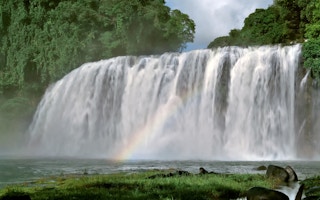While Lake Lanao remains the dominant source of hydroelectricity in Mindanao, there are other sources of similar clean energy waiting to be developed. 11 ideal hydropower plant locations have already been identified, according to the Climate Change and Clean Energy (CEnergy) Project.
Almost 20 years ago, then energy undersecretary Rufino Bomasang told participants of a media briefing on business and economics reporting convened by the Press Foundation of Asia at Los Baños, Laguna: “Our shortage of electricity is a real, serious problem that we cannot downplay. But if we focus exclusively on it, we run the risk of seeing just the trees and not the forest.”
The scenario has not changed even until now. While power supply in Metro Manila is sufficient “for now,” to quote the words of Atty. Victor Lazatin, lawyer of the Manila Electric Co. (Meralco), the demand is expected to increase in the summer months, peaking at 17 percent in April.
The result: rotating brownouts.
Speaking in London in June 1997, then British Environment Michael Meacher said: “Energy policies should be designed to promote cleaner, more efficient energy use and production. We want a new and strong drive to develop renewable energy sources. Doing so will create jobs, win exports and protect the environment.”
“
Mindanao, the country’s second largest island, gets its power from four major sources: hydropower, coal, geothermal, and oil. The bulk – 662 MW or 52 per cent – comes from hydropower.
Perhaps one environment-friendly source of energy that has not been fully tapped until now is water, which covers over 70 per cent of the earth’s surface. Electricity produced by water movement has been used for decades. About 16 per cent of the world’s electricity is generated by hydropower.
A World Bank report in the 1980s showed the Philippines as one of the “13 largest additions to hydroelectric capacity in developing countries.” From an operating capacity of 940 MW in 1980, it went up to 2,195 MW in 1985. In 1998, the total hydropower capacity stood at 2,304 MW or almost 20 per cent of the country’s total installed capacity.
Electric power is measured in units called watts. A watt is equal to one joule per second. The total generating capacity of a power plant is measured in kilowatts (kW) for 1,000 watts and megawatts (MW) for one million watts.
Mindanao, the country’s second largest island, gets its power from four major sources: hydropower, coal, geothermal, and oil. The bulk – 662 MW or 52 per cent – comes from hydropower. Oil contributes 24 per cent of the power supply (311 MW) while geothermal is the source of 8 per cent (98 MW). The remaining 16 per cent (203 MW) comes from coal.
“We are heavily dependent on hydropower which is coming only from one source, Lake Lanao,” says Manuel ‘Bobby’ Orig, first Vice President for Aboitiz Power Corp. in Mindanao. “This is the reason why during summer months or during long dry spells, when water level in Lake Lanao is very low, the power supply in Mindanao is gravely affected.”
But there are other sources of hydropower in Mindanao waiting to be tapped, according to the Climate Change and Clean Energy (CEnergy) Project. An initiative spearheaded by Mindanao Development Authority (MinDA) and Department of Energy (DOE), it is funded by the United States Agency for International Development (USAID).
In a recent media briefing, CEnergy — basing its report on Mindanao Renewable Energy Resource Assessment Project — cited 11 potential sites for hydropower plants in the regions of Caraga, Soccsksargen, and Davao.
In the Caraga region, the rivers of Bega, Misli, and Maug and Gibong are the potential sites for a run-of-river hydropower plant. Bega and Misli rivers would generate 1.4 MW and 800 kW, respectively. The Maug and Gibong rivers have a combined potential of 8.5 MW.
The Badtasan and Tran rivers in Soccsksargen are the identified potential sites for mini-hydropower plants. The respective potential power production of each river is 8,000 kW and 350 kW.
In Davao, the Mangkangay and Dumago-ok rivers in Davao Oriental, and Miral reservoir site and Kapatagan in Davao del Sur are potential sites for mini-hydropower plants. Two waterfalls (Alop and Kidadan) in Davao del Sur are also potential sites for micro-hydropower plants.
All in all, the potential power they can produce together is 4,417 kW: 300 kW from Mangkangay River, 3,000 kW from Dumago-ok River, 300 kW from Miral reservoir site, 800 kW from Kapatagan, 17 kW from Alop falls, and 60 kW from Kidadan falls.
Meanwhile, the Sibulan Hydroelectric Power Plants in Sta. Cruz, Davao del Sur, for instance, have been generating 42.5 MW for Davao since 2010. Composed of two cascading plants, the Sibulan Hydro A produces 16.5 MW and the water that it utilizes is reused in the Sibulan Hydro B to produce another 26 MW.
Most of the hydropower plants in the country are in the form of a dam that backs up the water and raises the level. Smaller hydropower plants, however, do not necessarily require dams. They use a series of pipes with turbines inside which are turned by the current.










